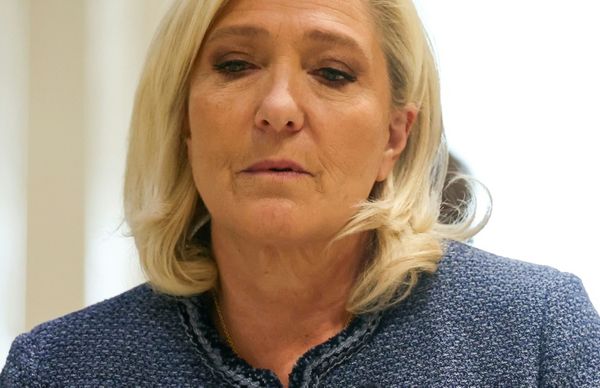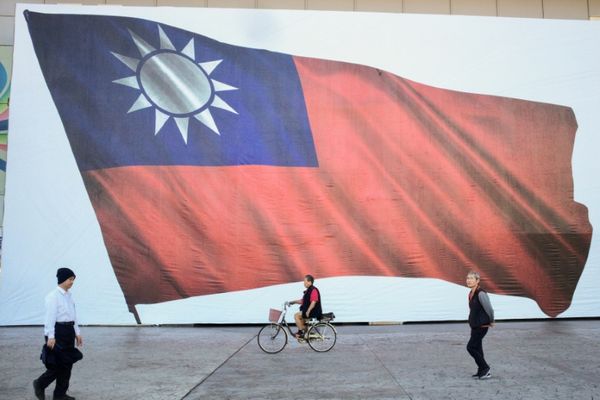As I drove away from the embassy of Israel on a bright Tuesday afternoon in Canberra, it was the image of a little girl in a dress with cornflower blue butterflies that brought the tears.
For the previous hour, a small group of journalists had sat in a conference room at the embassy, watching a large television screen.
The footage we were watching was being shown for the first time in Australia, and only the third time in the world. It has been tightly held out of respect for the victims.
"These are our family, friends and relatives," a spokesperson for the embassy says, before warning us to "protect ourselves" and to leave the room if what we were watching became too much.
The footage being shown was a collection of clips from the Hamas attacks of October 7, when terrorists crossed the border into Israel and slaughtered more than 1400 Israelis.
The embassy was showing the footage, because, in the words of its spokesperson, it had an obligation, a necessity, to show that "when we say children were murdered and women were raped" it was because that was what happened.
We knew, before attending, that we were to be shown uncensored footage from the day of the attacks. That it would be raw, confronting, distressing. The embassy staffer helping us through the tight security checks warned: "This will be tough guys." He was right.
Why then, did we attend? Because as journalists we bear witness. The job of the media is sometimes to see things so that our readers do not have to.
It was important, essential even, that someone from The Canberra Times be present. I attended because, while I lead a team of dedicated and capable journalists, for the first time in my editing career I couldn't bring myself to ask someone else to do the job.
In a conflict riven by ancient hatreds, some will no doubt say that this is the media being used for propaganda, and that we have seen inhumanity and heartbreak on both sides.
All I can do is describe what I saw. If you don't want to know, stop reading now. But know this: some things cannot be unseen or erased from history, and what I saw on that screen in that conference room will stay with me forever.
WHAT THE VISION SHOWS

The footage is labelled October 7, 2023, Hamas Massacre Collected Raw Footage. It runs for around 43 minutes.
The images have come from Hamas body cameras, CCTV footage, social media and the mobile phones of victims, among other sources. The embassy staff tell us these clips have been culled from hundreds of hours of footage.
It begins with vision from a Hamas mobile phone. Shots are being fired through the windscreen of a small silver hatchback; as it drives past a line of gunmen they strafe it. The car crashes into a four-wheel-drive. Two people inside are slumped, dead.
A heavy machine gun is fired from a distance into a car. A body is on the ground. Jeans and training shoes. Face down.
CCTV traffic camera footage shows Hamas gunmen, apparently wearing stolen Israeli Defence Force uniforms, shooting into a black car, before they drag out a body.

CCTV from the gates of Kibbutz Be'eri shows Hamas gunmen at the gates, breaking into a guard hut. They shoot into a blue hatchback that then slowly rolls towards the gates. The passenger is wearing a white shirt. Blood quickly stains it.
Inside a kibbutz, Hamas body cam footage shows a dog being shot. Then a tidy yard - a home. An outdoor setting. Pot plants and normality. A Hamas gunman begins to set the house on fire.
In another clip, an attacker cuts through a window screen. Gunmen enter the house. The occupants have fled, leaving a mobile phone or iPad still glowing on the kitchen table.
And then, home CCTV footage from Kibbutz Netir. A father and two boys run through a house in their underwear, through the back door and into an outbuilding. A Hamas attacker throws in a grenade. The father is killed. The gunmen go in and shepherd out the two dazed and bloody children.
They take them back into the kitchen of the house, where a Hamas gunman casually goes through the refrigerator before drinking from a bottle of Coke.

The boys have left bloodied footprints on the tiles. They sit, one on the lounge, another at the dining table. One says: "I want my mum". Then, "Itay, I think we are going to die." One boy asks the other about his bleeding eye: "You can't see anything?" He tries to help him by pouring water on his wounds. Then one of the boys says: "Why am I still alive?"
We aren't told what happened to the boys. The embassy staff don't know.
At Kibbutz Be'eri, bodies are pulled from a Mazda and left on the road. Hamas attackers get into the car and drive away, leaving the bodies beside an upturned Esky and the ransacked contents of the vehicle.
Then, to Hamas mobile phone footage. A body on the ground is being attacked with a hoe. Brutally. Viciously. With blow after blow.
More Hamas mobile phone footage: bodies are completely covering the floor of a room. Bodies in beds, shot where they slept. A woman dead shot in her bathroom. And blood. Pools of it. Trails of it.
And then the babies. Tiny bodies, brutalised. At least one with an unspeakable head wound.
Children, from tiny to perhaps aged 7 or 8. One is wearing Mickey Mouse pyjamas. Some faces are blurred.
At 26 minutes and 40 seconds into the video, a Hamas gunman uses an Israeli woman's phone to call his family back in Gaza.
"Dad, I'm in Miflasim," he says in Arabic, according to a translation provided by the embassy. "Look at your WhatsApp and tell Wian. See how many I killed with my bare hands dad. Your son killed Jews."
"Dad, I killed 10. Ten with my bare hands. Their blood is on my hands."
The footage continues. Bodies piled at a bus stop where people had been waiting for a trip to the Dead Sea. Young Israeli soldiers huddled in terror at a military base. People hiding under a table before being shot in the light of head torches worn by the Hamas attackers. Decapitated soldiers. Hamas gunmen shooting indiscriminately into a line of yellow portaloos. Panicking civilians hiding in a garbage skip. A person lying at the back of a car shot at point-blank range.
Bodies burnt beyond recognition. What appear to be burnt children.
Hostages being loaded into the back of a ute, at least one badly wounded.
"Here they are, bring them, let's take a selfie," an attacker says.
The body of a woman, her skirt pulled up and her underwear removed.
And amid it all, the little girl in the white dress with cornflower blue butterflies. She is not sleeping. She is dead. The picture of her body was on the screen for a split second, but in a torrent of atrocities, of horror, it is like a polaroid snapshot in my mind. A child ripped from a place of safety, a place of warmth and comfort, and murdered.
And outside, bright Canberra sunshine. And tears.
- Rod Quinn is the editorial director of ACM, publisher of this masthead.







